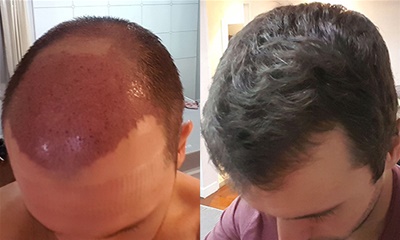
Thanks to modern medicine we no longer have to accept going bald. Surgical hair restoration is virtually undetectable to the general public when done right. However, there are a few telltale signs of surgery that make surgery obvious.
In this article, we will provide 3 easy ways to conceal a hair transplant and return to work.
What To Expect After A Hair Transplant Procedure
Immediately following a hair transplant procedure the scalp is typically pink with tiny scabs forming around the micro-incision sites. The tiny graft incision sites heal rapidly within 7-10 days. After surgery, the scalp may experience some minor swelling and redness. Typically, the redness clears up and fades after a few weeks, but can prolong for months in pale-skinned individuals. This prolonged redness can make the hair transplant obvious. Thankfully, we'll be providing tips to conceal this issue.
Tip 1: Longer Hair
Having long hair can hide scabbing and the areas where follicles were transplanted. Some physicians have perfected transplanting follicular unit grafts in between longer hair. Unfortunately, most surgeons require patients to shave their head for surgery, but a select few offer this "celebrity" procedure. Coined celebrity because most celebrities opt for this type of procedure since it can be concealed easily.
Tip 2: Hair Loss Concealers
Hair loss concealers such as Toppik and DermMatch can be helpful at concealing a hair transplant procedure. However, it is important to allow the scalp to fully heal before using hair loss concealers. There have been rumors, myths, and old wives tales' that hair loss concealers clog pores. In fact, some individuals believe that using hair loss concealers will somehow suffocate hair follicles and cause them to die. This is not true. Hair loss concealers can help patients get through the dreaded "ugly duckling phase".
Tip 3: Cover-up
For some fair-skinned patients, redness can persist for several months and this can lead to uncomfortable questions and stares. Luckily, this issue can be resolved with cover-up makeup. Cover-up is used to disguise or conceal blemishes on the face, but it can also be used to conceal the redness after surgery.
Conclusion
Hair transplant patients go through great lengths to keep their procedures a secret from co-workers, friends and loved ones. As the saying goes, honesty is the best policy. Doing nothing and being honest is the easiest way to deal with a hair transplant procedure. The vast majority of people will be curious, but afterward will move on with their lives and forget about it.

